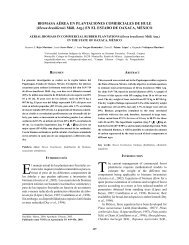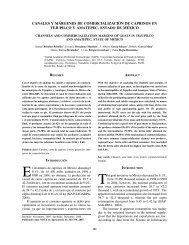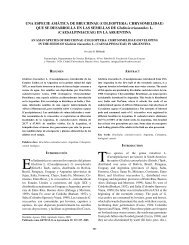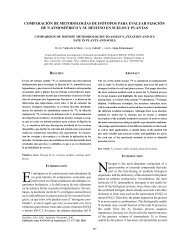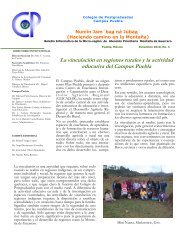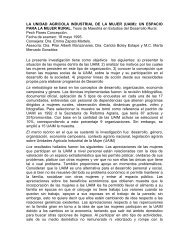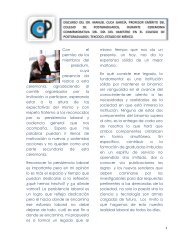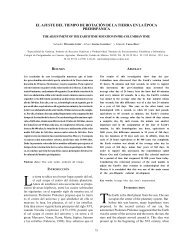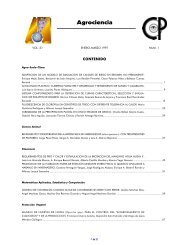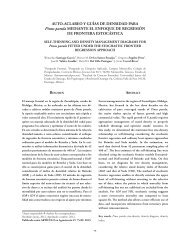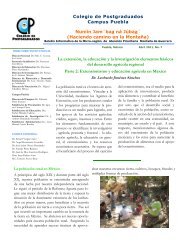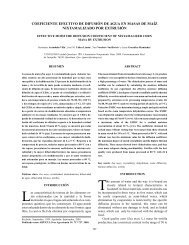04-161 (Regeneración in vitro) - Colegio de Postgraduados
04-161 (Regeneración in vitro) - Colegio de Postgraduados
04-161 (Regeneración in vitro) - Colegio de Postgraduados
You also want an ePaper? Increase the reach of your titles
YUMPU automatically turns print PDFs into web optimized ePapers that Google loves.
establecer el nivel hormonal endógeno a<strong>de</strong>cuado que <strong>in</strong>fluyera<br />
positivamente en las células <strong>de</strong> los ápices <strong>de</strong> raíz<br />
en su capacidad para regenerar plantas. Lo anterior obe<strong>de</strong>ce<br />
a que la respuesta <strong>de</strong>l explante está en función <strong>de</strong><br />
los niveles hormonales endógenos <strong>de</strong> éste durante el cultivo<br />
<strong>in</strong> <strong>vitro</strong> (Fehér et al., 2003). La función <strong>in</strong>ductora<br />
<strong>de</strong>l 2, 4-D en la embriogénesis somática ha sido observado<br />
por otros autores (Van <strong>de</strong>r Valk et al., 1992; Zeng<br />
et al., 1998; Myers y Simon, 1998), y se confirma con<br />
los resultados <strong>de</strong>l presente trabajo. Se ha <strong>de</strong>mostrado que<br />
el 2, 4-D estimula la síntesis <strong>de</strong> otras aux<strong>in</strong>as como el<br />
ácido <strong>in</strong>dol acético (AIA) en células <strong>de</strong> zanahoria (Daucus<br />
carota L.) (Michalczuk et al., 1992). Asimismo, se ha<br />
propuesto que el 2, 4-D podría actuar no sólo como una<br />
aux<strong>in</strong>a, s<strong>in</strong>o también como un herbicida, el cual <strong>in</strong>duce<br />
respuestas a estrés (Grossmann, 2000). Lo anterior se<br />
fundamenta en el hecho <strong>de</strong> que la presencia <strong>de</strong>l 2, 4-D<br />
en el medio <strong>de</strong> cultivo <strong>in</strong>duce la expresión <strong>de</strong> varios genes<br />
relacionados con el estrés en células <strong>de</strong> alfalfa (Medicago<br />
sativa) (Györgyey et al., 1991; Davletova et al., 2001).<br />
Tres semanas <strong>de</strong>spués <strong>de</strong> que los callos se transfirieron<br />
al medio F (libre <strong>de</strong> reguladores <strong>de</strong>l crecimiento)<br />
triplicaron su tamaño, advirtiéndose la presencia <strong>de</strong> algunos<br />
embriones <strong>de</strong> los cuales emergían el vástago y la<br />
raíz para convertirse en plantas. El estudio anatómico,<br />
que permitirá corroborar la ontogenia y bipolaridad <strong>de</strong><br />
los embriones, está en proceso. El mantener las plantas<br />
en los medios G (1 mg L −1 <strong>de</strong> BA), H (0.5 mg L −1 <strong>de</strong><br />
BA) y F promovió su crecimiento hasta un tamaño en el<br />
cual pudieron someterse a un tratamiento que <strong>in</strong>dujera la<br />
formación <strong>de</strong> microbulbos.<br />
Las plantas regeneradas <strong>in</strong> <strong>vitro</strong> que se mantuvieron<br />
a 4 °C por 15 d, formaron microbulbos en su base dos<br />
semanas <strong>de</strong>spués <strong>de</strong> retiradas <strong>de</strong> esta condición. Los<br />
microbulbos cont<strong>in</strong>uaron su crecimiento hasta convertirse<br />
en bulbos que alcanzaron un tamaño <strong>de</strong> 3 cm <strong>de</strong><br />
diámetro <strong>de</strong>spués <strong>de</strong> 32 semanas <strong>de</strong> haber <strong>in</strong>iciado el<br />
cultivo <strong>de</strong> ápices (Figura 1E), y a las 52 semanas <strong>de</strong> tal<br />
<strong>in</strong>icio, las plantas <strong>de</strong> cebolla obtenidas <strong>de</strong> estos bulbos<br />
aún cont<strong>in</strong>uaban su crecimiento en el <strong>in</strong>verna<strong>de</strong>ro (Figura<br />
1F).<br />
Aunque Dunstan y Short (1978) emplearon ápices<br />
<strong>de</strong> raíces para regenerar plantas <strong>de</strong> algunas varieda<strong>de</strong>s<br />
<strong>de</strong> cebolla (Giant Zittau e Inai Early Yellow), era necesario<br />
establecer las condiciones <strong>de</strong> cultivo <strong>in</strong> <strong>vitro</strong> que <strong>in</strong>dujeran<br />
la mejor respuesta en varieda<strong>de</strong>s <strong>de</strong> <strong>in</strong>terés para<br />
México como Cristal y El Toro. Asimismo, aunque se ha<br />
reportado la regeneración <strong>de</strong> plantas <strong>de</strong> cebolla a partir<br />
<strong>de</strong> otros explantes (Van <strong>de</strong>r Valk et al., 1992; Mohamed-<br />
Yasseen y Splittstoesser, 1992; Saker 1997; Zheng et al.,<br />
1998), la mayoría <strong>de</strong> estos protocolos sólo contemplan la<br />
fase <strong>in</strong> <strong>vitro</strong>, por lo que no proporcionan <strong>in</strong>formación acerca<br />
<strong>de</strong> el tiempo requerido para el establecimiento <strong>de</strong> las plantas<br />
en suelo, ni se ha dado seguimiento al <strong>de</strong>sarrollo <strong>de</strong> la<br />
REGENERACIÓN <strong>in</strong> <strong>vitro</strong> DE PLANTAS DE CEBOLLA (Allium cepa L.)<br />
calluses of the Cristal variety were more friable and more<br />
<strong>in</strong>tensely yellow than those of El Toro variety, this means,<br />
there were differences among genotypes, which agrees<br />
with Novák et al. (1986), who found differential<br />
pigmentation among genotypes.<br />
Embryogenic calluses (Figure 1B) were <strong>de</strong>veloped<br />
<strong>in</strong> presence of 2,4-D alone, as well as <strong>in</strong> comb<strong>in</strong>ation<br />
with k<strong>in</strong>et<strong>in</strong>. However, plants produced by these calluses<br />
were less numerous when embryogenic calluses were<br />
<strong>in</strong>duced to media conta<strong>in</strong><strong>in</strong>g 2, 4-D and k<strong>in</strong>et<strong>in</strong> (Table<br />
3). These results contrast with those reported by Robledo-<br />
Paz et al. (2000) and Van <strong>de</strong>r Valk et al.(1992) for garlic<br />
and onion tissues, but agree with what was observed <strong>in</strong><br />
embryogenic cultures of peanut (Arachis hypogaea L.)<br />
(Baker and Wetzste<strong>in</strong>, 1994) and pepper (Capsicum<br />
annuum L.) (Ste<strong>in</strong>itz et al., 2003). The <strong>in</strong>significant<br />
<strong>in</strong>fluence of k<strong>in</strong>et<strong>in</strong> on onion plant regeneration might<br />
be due to the fact that the utilized levels of this<br />
phytoregulator were higher or lower than the<br />
concentrations, required to establish an a<strong>de</strong>quate<br />
endogenous hormone level, that could have a positive<br />
effect on the cells of the root tips <strong>in</strong> their capacity of<br />
regenerat<strong>in</strong>g plants. The previous is due to the fact that<br />
the response of the explant is a function of its endogenous<br />
hormone levels dur<strong>in</strong>g <strong>in</strong> <strong>vitro</strong> culture (Fehér et al., 2003).<br />
The <strong>in</strong>ductive function of 2, 4-D <strong>in</strong> somatic<br />
embryogenesis has been observed by other authors (Van<br />
<strong>de</strong>r Valk et al., 1992; Zheng et al., 1998; Myers and<br />
Simon, 1998) and is confirmed by the results of the<br />
present paper. It has been <strong>de</strong>monstrated that 2, 4-D<br />
stimulates the synthesis of other aux<strong>in</strong>s, like <strong>in</strong>doleacetic<br />
acid (AIA) <strong>in</strong> carrot (Daucus carota L.) cells (Michalczuk<br />
et al., 1992). Likewise, it has been suggested that 2, 4-D<br />
might act not only as an aux<strong>in</strong>, but also as herbici<strong>de</strong>,<br />
which generates responses to stress (Grossmann, 2000).<br />
The aforesaid is based on the fact that 2, 4-D presence <strong>in</strong><br />
the culture medium orig<strong>in</strong>ates the expression of several<br />
genes related to stress <strong>in</strong> cells of alfalfa (Medicago sativa)<br />
(Györgyey et al., 1991; Davletova et al., 2001).<br />
Three weeks after the calluses had been transferred<br />
to medium F (without growth regulators), they tripled<br />
their size, and the presence of some embryos was<br />
perceived, whose shoot and root emerged to become<br />
plants. The anatomic study, which will permit to<br />
corroborate ontogeny and bipolarity of the embryos, is<br />
be<strong>in</strong>g conducted. Keep<strong>in</strong>g the plants <strong>in</strong> media G (1mg<br />
L −1 of BA), H (0.5 mg L −1 of BA), and F, promoted their<br />
growth until reach<strong>in</strong>g a size where they could be subjected<br />
to a treatment, which would <strong>in</strong>duce microbulb formation.<br />
Plants regenerated <strong>in</strong> <strong>vitro</strong>, be<strong>in</strong>g ma<strong>in</strong>ta<strong>in</strong>ed at 4 °C<br />
for 15 days, formed microbulbs at their base, two weeks<br />
after be<strong>in</strong>g removed from this condition. The microbulbs<br />
cont<strong>in</strong>ued their growth until they turned to bulbs, reach<strong>in</strong>g<br />
a diameter of 3 cm after 32 weeks of <strong>in</strong>itiat<strong>in</strong>g the culture<br />
QUINTANA-SIERRA et al.<br />
653



